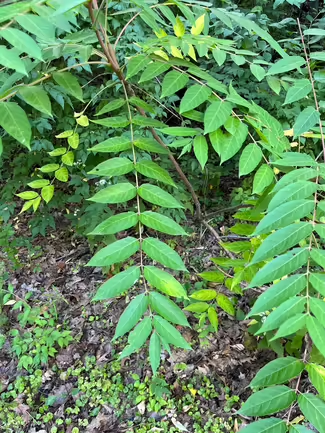
Two separate serendipitous events occurred recently that brought a plant back to the forefront of my attention. First, a few weeks ago a colleague asked me to confirm the species of a tree growing near a public garden. The garden was struggling to grow, and a cursory identification of the tree marked it as Black Walnut (Juglans nigra). Having earned a reputation for suppressing the growth of other plants through the production of a growth-inhibiting chemical, and having large, compound leaves, the culprit seemed to be identified. Upon arrival, instead of finding black walnut, I found Ailanthus altissma, also known as tree-of-heaven.
The second unexpected time Ailanthus altissima became part of my daily conversation was a few weeks ago when Spotted lanternfly was confirmed to have been found in Illinois. Spotted lanternfly is an invasive pest that sap sucks on the stems, branches, and trunks of woody plant material. It can reduce plant vigor and produce an abundance of honeydew, a sticky, sugary substance excreted by the insect. Spotted lanternfly feeds on many orchard and ornamental plants including grape, apple, stone fruits, maples, walnut, and willow. However, its preferred host plant is Ailanthus altissima, tree-of-heaven.
In the beginning
Tree-of-heaven is native to northern China and was introduced to France in the early 1740s by amateur botanist Father Pierre Nicolas Le Cheron. Within a few short decades, the tree had spread throughout Europe. While on a plant collecting expedition in 1784 to Europe, plant collector William Hamilton secured the seeds of both Ginkgo biloba and Ailanthus altissima, introducing the species to North America.
During the height of the Industrial Revolution, Ailanthus altissima was promoted in the nursery industry for its vigorous growth, tolerance of urban pollution, and indifference to poor soils. In the urban environment during a time when window screens were not yet available, the tree’s shade was desired as much as its canopy being unappealing and unsupportive of insect life. For these reasons and more, the tree became the most common street tree planted in the urban environment.
This plotline is, unfortunately, a familiar one. Many of our current invasive species were once promoted by authorities.
Ailanthus altissima
Ailanthus altissima is a fast-growing tree that can reach heights of eighty feet. Large, alternately arranged, compound leaves have 11 to 25 leaflets. Each leaflet has one or more glandular serrations near the base which is helpful for identification. Large floral clusters of yellowish-green flowers emerge in the spring on female trees. Flowers are said to have an unpleasant odor described by some like cat urine or rancid nut butter. If pollinated, an abundance of seeds are produced each year perpetuating the challenge of control.
The bark of tree-of-heaven is smooth throughout its life cycle compared to that of a cantaloupe rind. The bark of younger trees have a greenish tinge to the brown bark that fades to light brown or gray with age.
An extensive root system and prolific seed production make the species difficult to control. Mechanical, physical, and chemical control strategies can be combined to combat an infestation. Tree-of-heaven is intolerant of shade and will not invade established woodlands. Look for the species along the edges of forests and wild space.
Look-a-likes
A few species of native trees can make identification complicated. Tree-of-heaven may be mistaken for black walnut, staghorn sumac, Kentucky coffeetree, and honeylocust. The serrations on the lower leaflets and the foul smell of the crushed twigs are useful identification characteristics.
Good Growing Fact of the Week: Ailanthus altissima is the species prominently featured in Betty Smith’s classic novel “A Tree Grows in Brooklyn”.
Sign up for our emails! Want to get notified when new Good Growing posts are available? SIGN ME UP
MEET THE AUTHOR
Emily Swihart is a Horticulture Educator with the University of Illinois Extension, serving Henry, Mercer, Rock Island, and Stark counties since 2021. Emily provides horticulture programming with an emphasis on trees, native vegetation, and home landscape design.

